Game Review: The Hundred Line - Last Defense Academy
From the creators of Danganronpa and Zero Escape comes a candidate for the longest game script in history... and that's not a good thing!
It was too big to be called a visual novel. Massive, thick, heavy, and far too rough.
Indeed, it was a heap of raw lines.
— Roger Ebert
Disclaimer: I usually keep my reviews spoiler-free, but I don’t recommend this game, so neither of us should care this time.
This is a highly negative rant I’m writing to exorcise my demons, but hopefully you’ll get some entertainment out of it.
As I stare at my 121 hours played on Steam and contrast them with the “38/100 endings” in-game counter, I feel a strong need to cut my losses and redeem my time spent, somehow. But not by coping and claiming it’s a masterpiece, no.
Hundred Line is an unmitigated disaster. Eliezer Yudkowsky famously said “you are trying to solve the wrong problem using the wrong methods based on a wrong model of the world derived from poor thinking and unfortunately all of your mistakes have failed to cancel out” and I think it sums up the planning stage for this game.
Fortunately, it’s an interesting mistake, one I will expound on in painstaking and hypocritical detail.
Hundred Line is a visual novel,
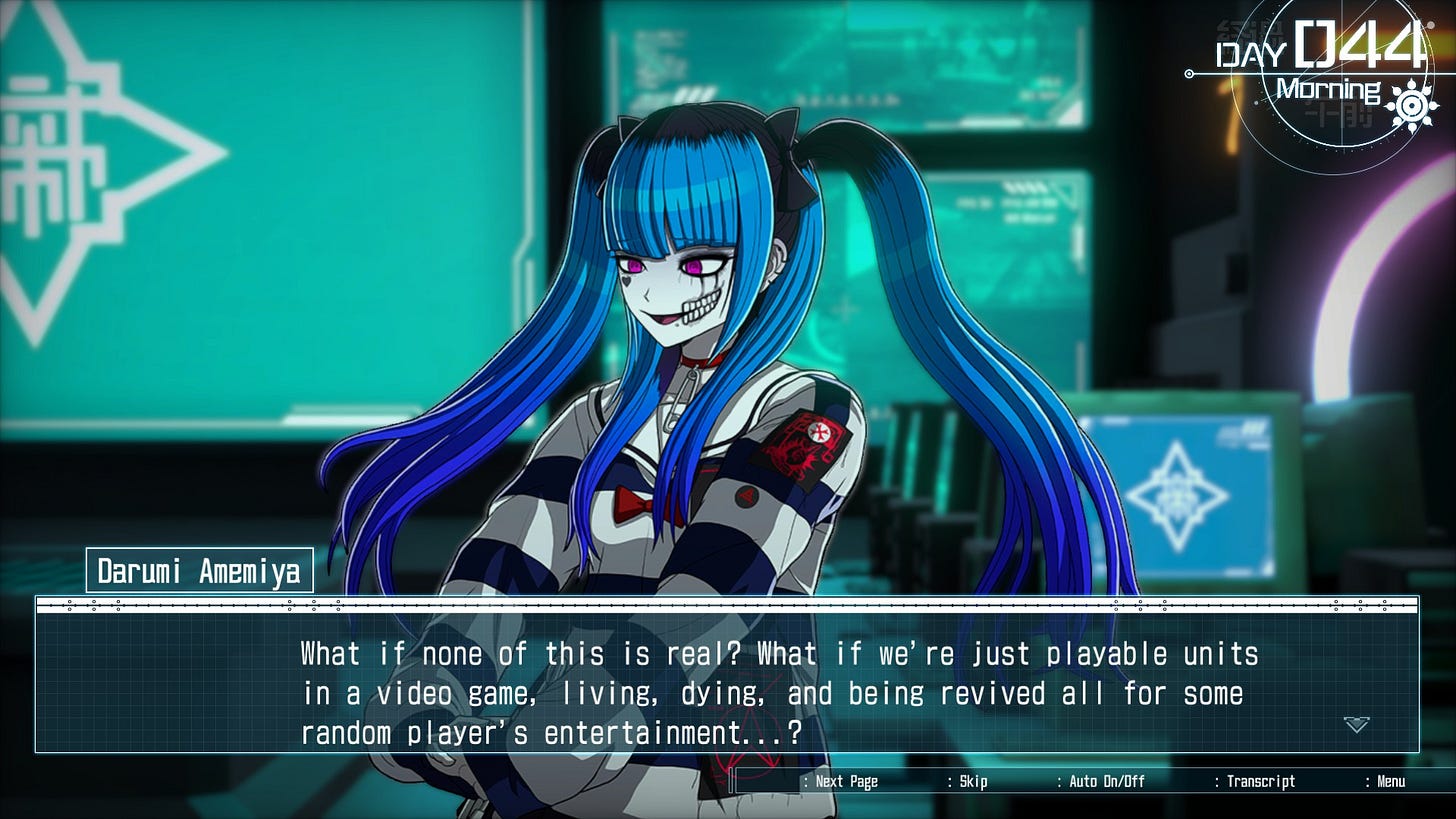
with some tactics segments,
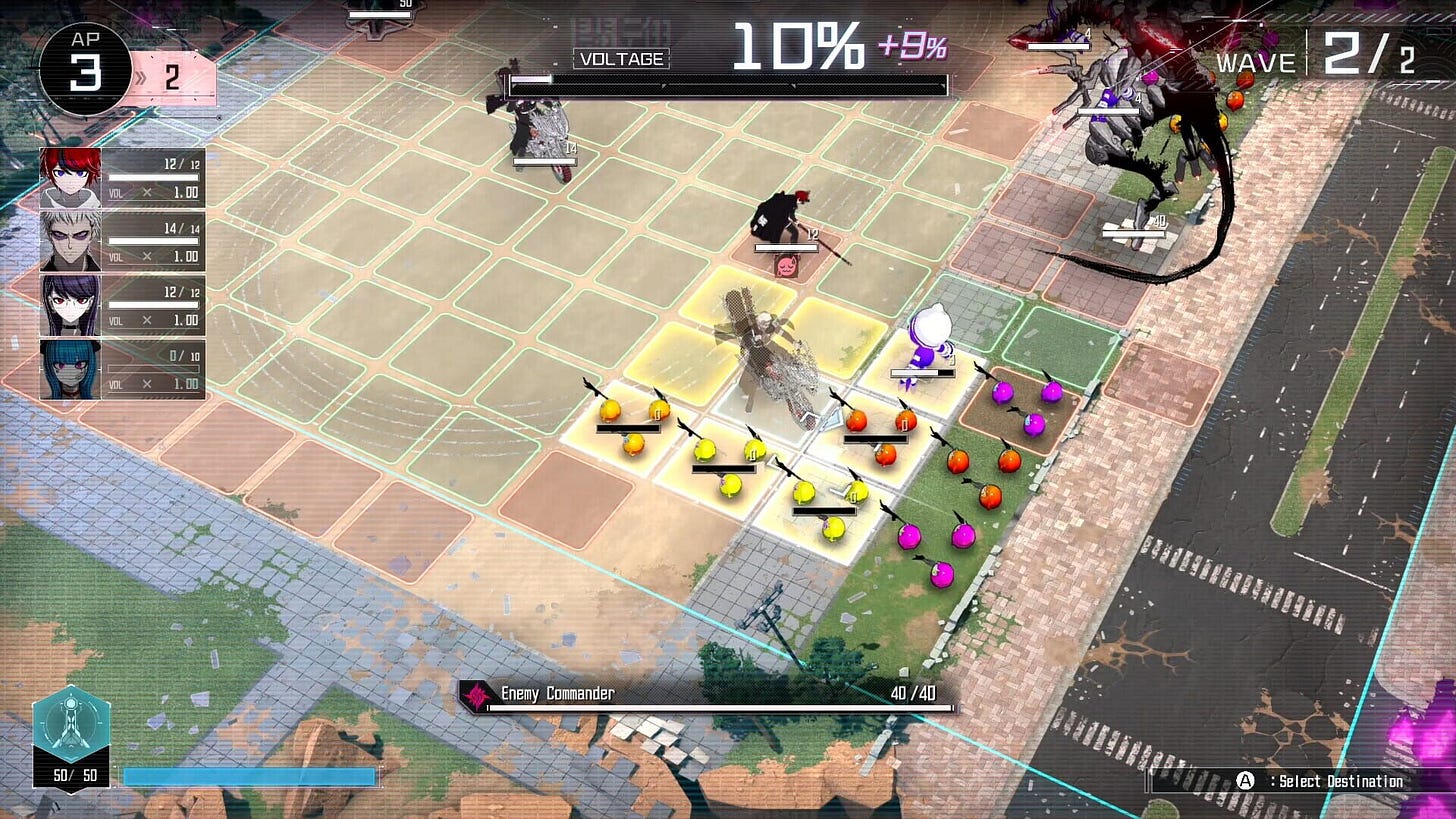
and the occasional jump into other genres.
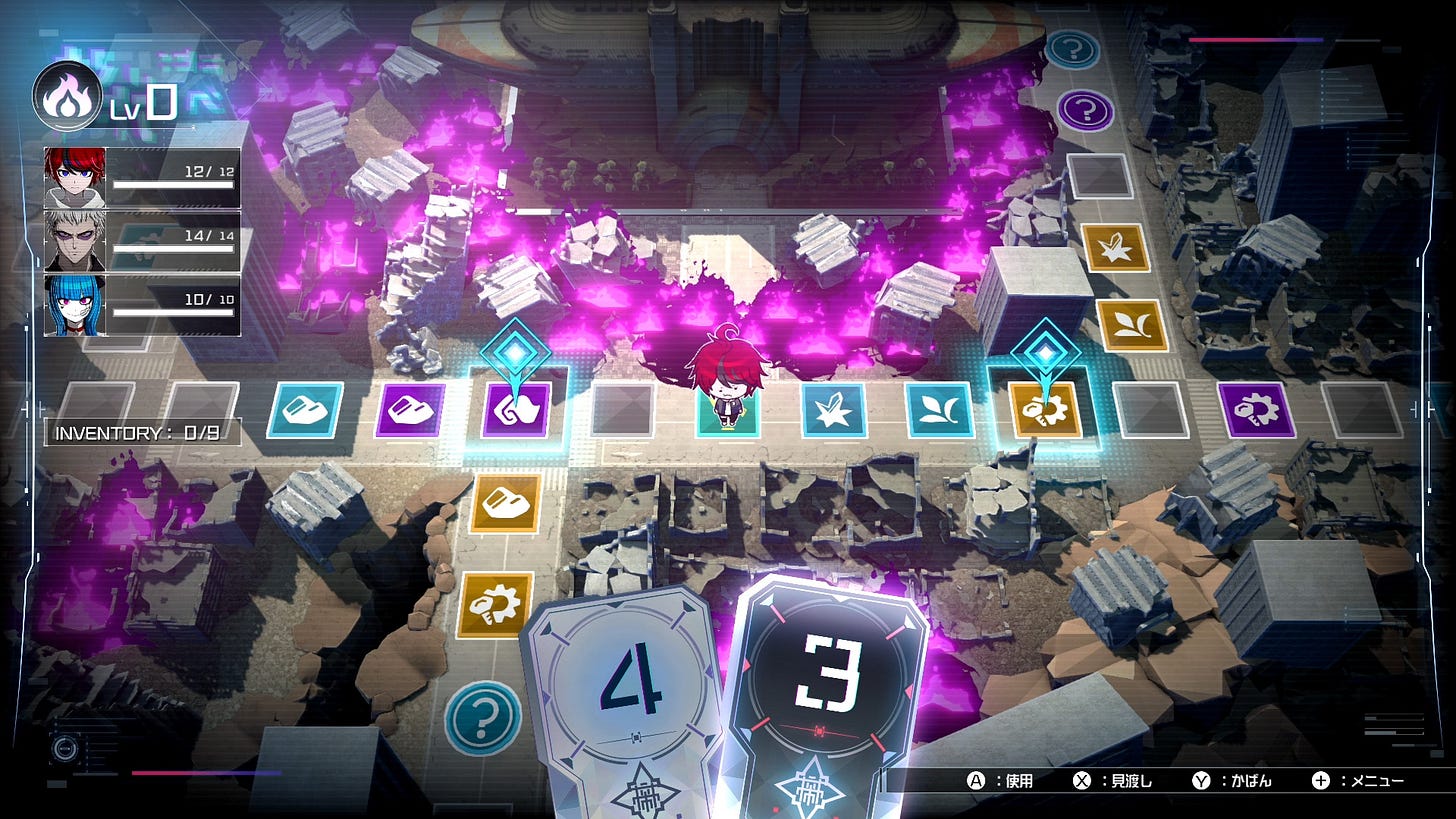
The plot is a bit of an ontological mystery with an Urban Sci-Fantasy backdrop. A bunch of almost-adults wake up in a school in the middle of a ruined city and are told they need to fight monsters to save Humanity. Humans are at this point hiding in shelters, and the school is protecting a secret weapon that will make the planet’s surface safe for human habitation.
Humanity is powerless against the monsters, but our protagonists have special blood that allows them to use “Hemoanima”. This ability lets its users transform and use cool weapons, leveling the playing field. The secret weapon within the Academy needs to charge for a hundred days before it can be deployed. Monsters will regularly attack it, and the students will regularly defend it.
So far so good. Maybe a bit generic, but with Kazutaka Kodaka and Kotaro Uchikoshi behind the wheel you can guarantee it’s filled with twists and turns.
Doesn’t a hundred days sound like a bit too many, though?
Danganronpa—the closest point of comparison for this game in almost every dimension—runs through 25 days in each of its entries. There are twists and murders every few mornings, and whenever the writer needs to let the players breathe, they give the players “Free Time” segments where they can talk with other characters and learn more about them.1
Multiplying that by four might be fine, since Danganronpa was mostly Kodaka behind the wheel, and Hundred Line has eleven scenario writers total. In fact, the density of events should be even tighter.2
This was my mindset as I started playing the game. It was slowly destroyed by reality. Hundred Line is less dense than usual. It has more Free Time segments, which often must be wasted on exploration minigames instead of character interactions, and some of the tactical fights feel like filler. There are deaths and plot twists, but they happen over 100 days instead of 24, so boredom is inevitable.
I reached the credits around thirty hours in. Some mysteries were revealed, some people died, some people escaped, but the experience was overall underwhelming.
Then, I noticed half of the credits were censored by black bars.
After they ended, I was abruptly sent back to the title screen, with the logo now saying The Hundred Line 2.
I had successfully beaten a prologue.
Your main character has used a (properly foreshadowed) time travel ability to return to Day 3, and the game is no longer linear, with many, many choices unlocking up to 100 new endings.
This reveal was the peak of my experience with Hundred Line. 25% into my total time spent.
Before I continue this rant, I have to be fair for a second. A lot of critics complain that those 100 endings are “fake”, and the majority would go uncounted in other games as sudden bad ends. I must go against the grain here. I think the game really is as big as the number makes it sound, that choices matter and unlock drastically different routes, with different genres and focii. There are 20 routes, and “one true ending, a couple neutral endings, and a couple bad endings” per route seems more than acceptable for any visual novel.
Does that mean I actually think more positively about the game than other critics? No, because I fucking wish most of those 100 endings were actually fake. I fucking wish the game was shorter in every possible way. In the first book of The Dark Tower, Stephen King wrote that Size is what defeats us, and I should have realized that was foreshadowing for my own life.
I already wrote one hundred days is too many. Now imagine that multiplied by 20.
Every route but one (named “2nd Scenario”, more on this later) is overall less eventful, less important than the Prologue. The non-prologue timeline is slightly altered by your arrival, so different things happen, sure, you get a new set of boss fights, but this set of boss fights is reused in all twenty paths.
Every issue the game has—every issue Danganronpa has, barring the pink blood—is magnified when exposed to the sheer repetition that comes with this baffling decision to keep any commonalities between the 20 routes.
The one-dimensional characters? The simplest ones died quickly in the Kodaka games, and you didn’t spend THAT long with the rest. Here, you’re going to have one character whose only jokes are “being an assassin” and “saying ‘For the love of murder’” stick around for so many hours of real time, it’ll start feeling like community service.
The simple non-VN gameplay? It’s not going to get any better after you master every aspect of it ten hours in,3 and every side story will have to contrive to include battles and exploration, no matter their genre.
UPDATE (2025/06/27): to their credit, a lot of the problems below seem to have been fixed in patches, so feel free to skip to the last paragraph of the upcoming section. The latest patch even adds a higher difficulty mode.
It looks like the devs are actually listening to feedback. It’s entirely possible that by the end of this we’ll end up with a game where the only bad part is the script.
I’m one hundred ten percent certain Kodaka read this review, by the way, so you’re welcome for that.
Even the aspects exclusive to this entry are ruined. Hundred Line has a lot of decently looking 3D cutscenes. They’re charming on the first go. On the second and further, they start feeling more like walls you have to crash through. Even when the longest are skippable, skipping them requires holding a button for a few seconds. I will remember a single monster saying “NYEUAH” for the rest of my life, since it’s the beginning of a cutscene preceding every one of the 500 mandatory battles.4
Outside of the tactics gameplay, every time you wake up and every time you go to sleep you have a prerecorded video from the academy headmaster essentially saying “good luck” and “good night” for multiple lines, which I’m sure helps make this the longest game script of all time.5
I’m getting tired of bringing up Danganronpa, but its equivalent is the decent and unique Monokuma Theater segment that played every day:
Having them replaced with generic pep talks that often repeat and have nothing interesting whatsoever to them, and having them combined with unskippable if short “bell sound plays, TV turns on” cutscene 2000 times…
“One hundred endings, twenty-one true routes” is the kind of idea that only sounds good on paper. Even people who love School Days (the closest attempt I know, with around 25% of each count) still prefer the single-route anime adaptation.6 Your producers were so preoccupied with whether or not they could, they didn't stop to think if they should.
So I’ve talked about the repetition and length, the true killers of this game’s potential.
What about the story? Ever 17 and Umineko—two very long and universally beloved visual novels—also have repetitive segments, but get redeemed by their highs and overall good writing. This could be the same situation.
Unfortunately, even pretending the filler isn’t there, this is one of the worst Uchikoshi scripts.7 That doesn’t mean it’s bad, but it means that I can’t recommend the game even to his fans.
I’ve already explained the rough shape of the plot, and details are coming. I admit it’s pretty hacky to say you’re writing a review and then deliver a summary, but I have to do it here. I do it to protect the Zero Escape and Infinity Series and Somnium Files fans out there, who might force themselves through days of pain just to see what the twists are.
For most of the game, you think the protagonists are a bunch of human kids that used to live in the Underground Tokyo Complex, that later unlocked an ability and got chosen to fight alien invaders on Earth’s surface.
Well, none of that is true.
Earth is gone. Humans pissed off "the spirit of the planet” with industrialization, wars and global warming, and it retaliated by causing a bunch of natural disasters. Humanity almost went extinct, but survived long enough to build a moon-sized space station and fuck off to a different planet to conquer and presumably ruin again.
This planet, Futurum, was chosen for its similarity to Earth. By sheer bullshit, its inhabitants look just like humans, but slightly less technologically advanced, and their planet’s spirit actually loves them. The planet grants a few of them the ability known as Hemoanima to turn into monsters and fight the human invaders. Even though Earth’s Artificial Satellite easily bombed the surface, they still can’t beat these monsters with regular weapons and finish the job.
Earth fails to take over the planet and gets increasingly desperate as the Satellite slowly breaks down over the years. Humans end up kidnapping the most powerful Futuran child, their Jesus-like figure, who can produce particularly damaging flames that can hurt other Hemoanima users. Then the child is put inside an Omelas machine and forced to fill a bunch of missiles with flames for a hundred days. Those missiles will then be launched from the school (actually a landed spaceship)8 and genocide the natives.
Our “heroes” are genetically modified clones of that child, biologically Futurans.9 They’re only partially successful clones, so the Hemoanima they get is kind of shitty in comparison, but at least there are more of them. To make them fight for humanity, they get implanted with a bunch of false memories about having friends and family in an underground complex that they must protect, and given random personalities so they can react to a variety of situations. This last reveal is only in the “2nd Scenario” route, which is written by Kodaka himself and is somehow the most fleshed out and competently developed one.
So yeah, you’re the baddies.
The fact you’re working for invaders trying to take over an innocent planet means that, modulo the variation each route presents, the final goal often involves destroying the genocide weapons before they fire. I say final because for most of the runtime characters are clueless and just try to survive the waves of enemies they face without really knowing why. You also always have to beat the one-note Final Boss, who despite being part of the innocent natives is still laughably evil.
I think “2nd Scenario”, the clone route, was probably written first,10 with that blueprint given to other writers to design their own spins on. These are the credits, which you are free to skim and probably should be a footnote, but I’m making a point:
Kazutaka Kodaka (Prologue, 2nd Scenario, Reset Route, Goodbye Eito Route, Eva Route, Multiple Eitos Route, Serial Battles Route, Cult of Takumi Route, V'ehxness Route, Retsnom Route, Comedy Route)
Kotaro Uchikoshi (Last Defense Academy Routes Scenario Direction, S.F. Route, Mystery Route)
Kyohei Oyama (In-Game Scenario, Rebellion Route, Comedy Route, Killing Game Route)
Akira Ogidou (Goodbye Eito Route, Multiple Eitos Route, Conspiracy Route, V'ehxness Route)
Ukyō Kodachi11 (Rebellion Route, Box of Blessings Route)
Kou Shigenobu (Eva Route, Casual Route)
Nonon Ishii (Serial Battles Route, Comedy Route)
Yoichiro Koizumi (Conspiracy Route, Romance Route)
Ren Sudo (Box of Calamity Route, Retsnom Route)
Akihiro Togawa (Coming-of-Age Route, Slasher Route)
Akira Mine (Slasher Route)
Too many cooks. You can already see that many writers only did one or two routes, and I bet barely looked at each other’s work. Uchikoshi also clearly failed to do his job of “scenario direction”. This leads to inconsistencies all over the place, both on the micro12 and macro13 level. It sounds charming when you get told the game is a genre-shifting masterpiece, but the genres are often lame and poorly executed.
I’m not going to go over every route, because I didn’t play all of them,14 but here’s a small summary of their uniquities:
2nd Scenario: all twists are revealed in detail, but everyone dies at the end.
Romance: exactly what it sounds like, every 25 days you get a new girl to date, and at the end you have to pick one to stay with. All non-dating time is filled with inconsequential battles and Free Time segments.
Slasher: zombies, justified with brain slugs. The brain slugs have another variety that invisibly take over alive people and make them kill their friends, which is the explanation for basically every other route that involves murders.
Box of Calamity/Box of Blessing: there are seven macguffins that work like Dragon Balls and seven fake macguffins that kill you and our protagonists want to find them. This is even stupider than it sounds, filled with fetch quest exploration segments to fill time, and the boxes are never used onscreen.15 Shaggy dog routes, just terrible.
Coming-of-Age: I suspect the original Japanese just says “Shonen Route”, because this is basically a spin on the 2nd Scenario where everything is solved with the power of friendship and some very loose logic.
Retsnom: written by the team’s worst writer, Ren Sudo, this is bad body horror fanfiction built entirely around the Darumi character and how she’s an abused woobie who did nothing wrong. It introduces a True Revival mechanic that isn’t mentioned in any of the other routes. Wow, it’s “Monster” backwards! I wish I was watching Troll 2.
Cult of Takumi: barring the batshit premise and the complete dearth of engaging gameplay, surprisingly decent “dark side path”.
Killing Game: despite the name, this isn’t a Danganronpa pastiche, but at least one character is killed every few days unless they kill X enemies, so I guess it’s exactly like Squid Games (I have never watched Squid Games). Surprisingly decent given the stupidity of the concept and the fact it involves giant bees.
Mystery: THIS is the Danganronpa pastiche, but you only get to solve three very simple murders, and then it fizzles out because it’s merely setup for the True Ending Route, which is…
Steady Fundamental:16 I think this was meant to be a victory lap of sorts, a true ending that introduces a machine that allows our protagonist to travel “laterally” to other routes. This resolves a lot of otherwise nonsensical mysteries that you’ve encountered so far.
Alas, it doesn’t reveal anything it didn’t itself set up,17 and while it leads to the happiest ending—with all 17 characters escaping to the Space Station AND destroying the Academy before it fires—it ends up a bit half-assed and unsatisfying. You really have to be disappointing for me to prefer the route where everybody dies.
You may be able to tell most of these don’t advance the “plot” in any way, and they’re not good on their own. At best they set up small hooks (like the brain slugs) that only truly matter in other side routes. At that point, why include them in the game,18 especially when the writing is not up to even Kodaka’s standards?19
Beyond the pointlessness and specific inaccuracies, I think there’s a fundamental incompatibility between Uchikoshi and Kodaka’s character writing styles. Uchikoshi wants slightly off but smart protagonists who solve their problems with smarts. Kodaka wants the dumbest guy ever acting as the straight man to a bunch of insane people, with all problems solved with either lucky detectives or The Power of Hope. In Hundred Line, the protagonist’s IQ shifts wildly between 10 and 300 based on the current route, and with the sheer variation of his goals it starts feeling like these aren’t people, they’re props. Like Andrew Hussie once wrote:20
Imagine that over the course of someone's life, they are truly capable of every conceivable action at any moment, and did indeed take each of those actions in different branching realities. Doesn't a scenario21 like that deaden a person's agency just as much as one where their fate is decidedly etched in stone as a single path of unavoidable decisions? Who exactly is that person who can and does take all conceivable actions, other than someone perfectly generic, who only appears to have unique predilections and motives when you examine the arbitrary path they happen to occupy?
You really wish the main character you’re stuck for a thousand bucks’ worth of minimum wage time would at least be likable.
The writing is underwhelming, the gameplay gets old, the structure and characters are just terrible, what even is left? It looks good, and the music is standard Danganronpa, I guess. There’s only one track I’d call great, though.
How could you fix this game without starting completely from scratch?
Remove the combat. Muv Luv is (I think) about anime people fighting aliens and not one person ever complained there are no tactics segments.
Turn the two “final routes” into one and make the experience more linear in general. Virtue’s Last Reward was a masterclass in how to give the player freedom while never making them feel punished for exploring.22
Back to 25 days. Make all the cutscenes as insta-skippable as dialogue, and omit repeated dialogue by default. Name it
Danganronpa in SpaceKeep all the routes that are extremely weird, discard all the ones that are just “2nd scenario plus macguffin hunt” or “2nd scenario but y character takes the spotlight”. They’re both incompatible with good pacing.
The best thing I can say about Hundred Line, as it is… there are some good ideas buried in the trash. Some better developer might one day be inspired by them. Otherwise, it was a terrible concept with bad execution that inexplicably comes from two of the best VN creators in the world.
This is why “guy that says no” is a load-bearing position in the creative industries. This time, though, you’ll have to be the one to say it.
I think this format is meant to directly pander to commuting teenagers and young adults, playing small bits at once. For regular play sessions, it isn’t great.
This is but the first of many monkey paws Hundred Line shares with the Homestuck sequels.
You can “skip” already played battles, but it just means you quickly see an auto-win sequence when it’s time to control the characters. You still have to see the preamble, the transformations, the in-battle dialogue, enemies entering the field, and so on, every single time.
As of the writing of this review the claim has been challenged by some, but I haven’t seen hard proof it’s false. Baldur’s Gate 3 and a few other visual novels might beat it, but the visual novels that get close aren’t localized, so it seems safe to say it’s the longest script for an English-translated visual novel at least.
That said, the record is meaningless when there’s so much filler.
Kodaka has always been kind of a meh writer saved by a “better than the sum of its parts” effect, and I can feel Uchikoshi’s influence in all the major twists, so I’m going to pretend he was the only writer for a while here, even though the other guy happened to write most of the good material this time around.
I kept waiting for the academy to fly away at some point and it never happens, total missed opportunity.
Incidentally, this summary has a lot of apparent plot holes that actually have decent explanations, which is at least better than Danganronpa. For example, Hemoanima only works on the surface of Futurum, so they have to be there in order to charge and fire the weapons, and the spaceship looks like a school because the special child’s biggest wish was going to school like other kids…
This also means that all but one of the many relationships in the game (only “many” because Hundred Line is endless) are incestuous, which the game says out loud.
The clone thing is never discovered or lampshaded in any route with romance, but it’s still an indelible part of canon.
Apparently this guy wrote the parts of Boruto everybody hates.
I don’t want to go into even more detail, but to give one example: the Academy has a revival machine that can return anyone to perfect health. This is mostly used for gameplay reasons: there are a bunch of powerful special attacks that also happen to kill the user, but there are multiple waves per battle and you want all characters available for each. This machine constantly fails for the dumbest of reasons like “lost too much blood”, but in other routes magically works even when someone was decapitated 500 meters away from the machine. Just a mess.
The game lampshades a lot of these. “BAD ON PURPOSE” never becomes charming.
The very first choice you get is whether to kill the guy who betrayed you in the previous timeline or let him live. If you kill him, you’ll get some borderline non-diegetic moralizing about how he hadn’t actually done anything wrong, he’s redeemable, etc. If you don’t kill him, you’ll see him end up betraying you again or managing to kill people regardless over and over and over. In the “happy” True Ending, you even have to use a brainwashing machine to make him manageable.
Correction: apparently they’re used onscreen in some of the most remote splits I didn’t see.
I don’t get the name. Best I can tell it’s just that it abbreviates to SF and it’s the most science-fictiony route.
It’s obvious this game had a huge budget compared to even Spike Chunsoft’s proper releases (there’s a complex history of the companies involved but this review is already way too fucking long). Even then, sometimes you can see the seams. The only 3D models are of the characters in their battle uniforms, so at one point one character has to randomly says she buried everyone in those uniforms so the 3D zombie versions you later escape from don’t randomly wear different clothes from the ones they died in. It’s really stupid.
"Scenario” is the word Japanese developers use for VN route scripts. This is not a coincidence because nothing is ever a coincidence.



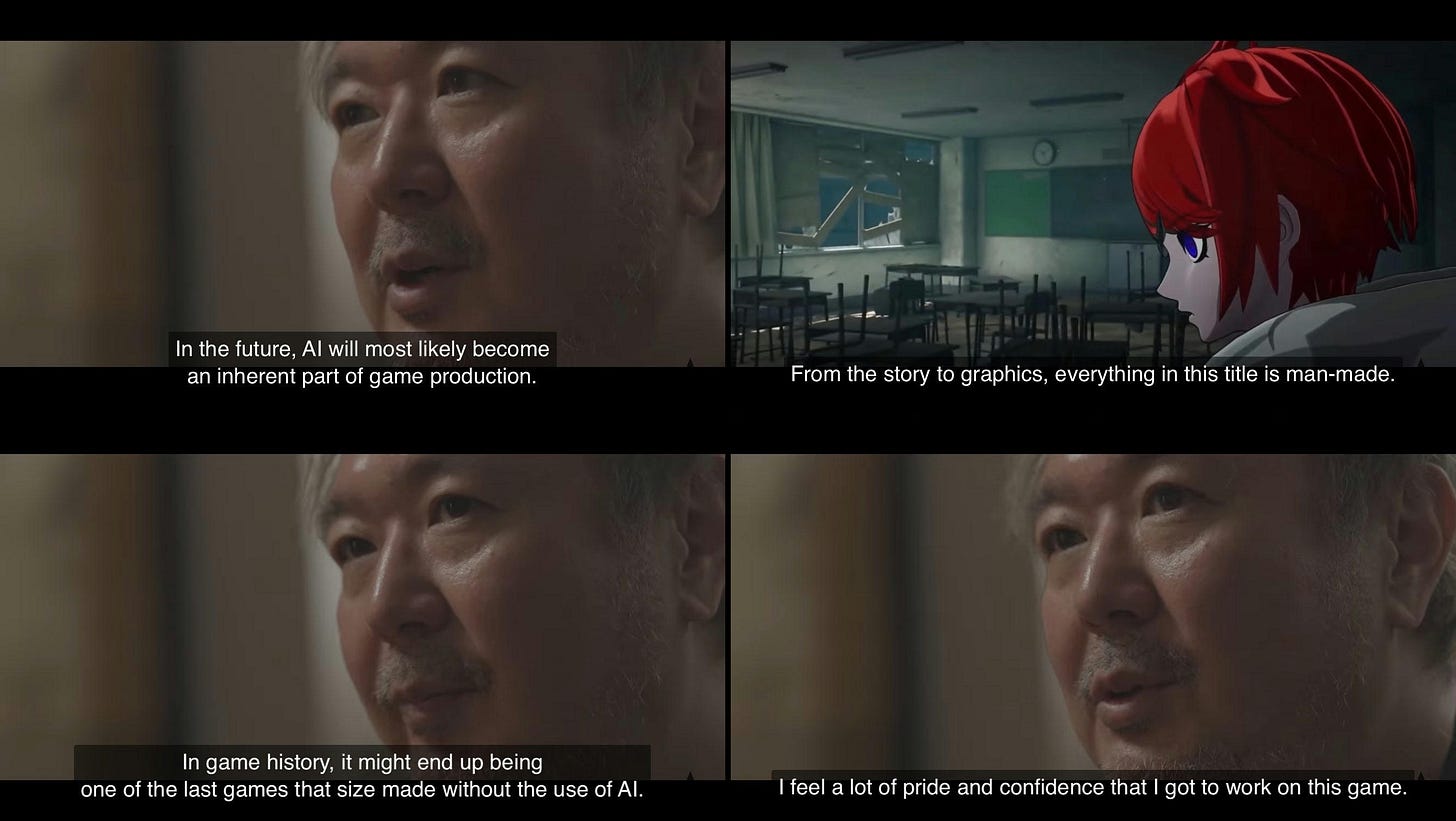
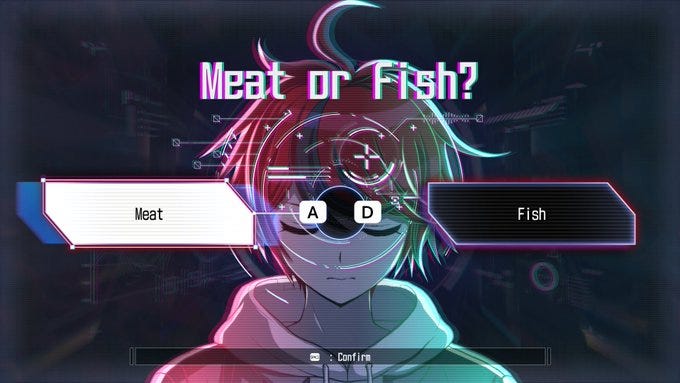

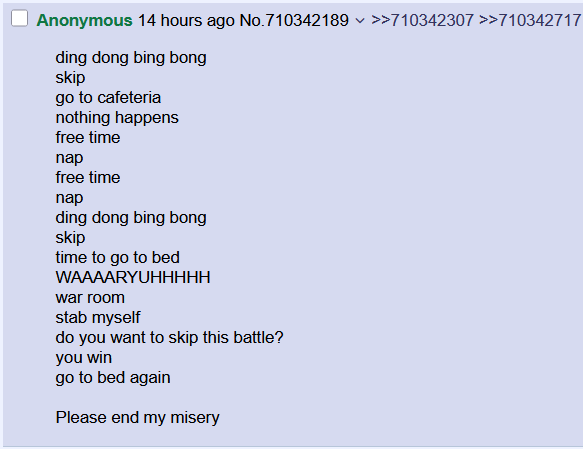
















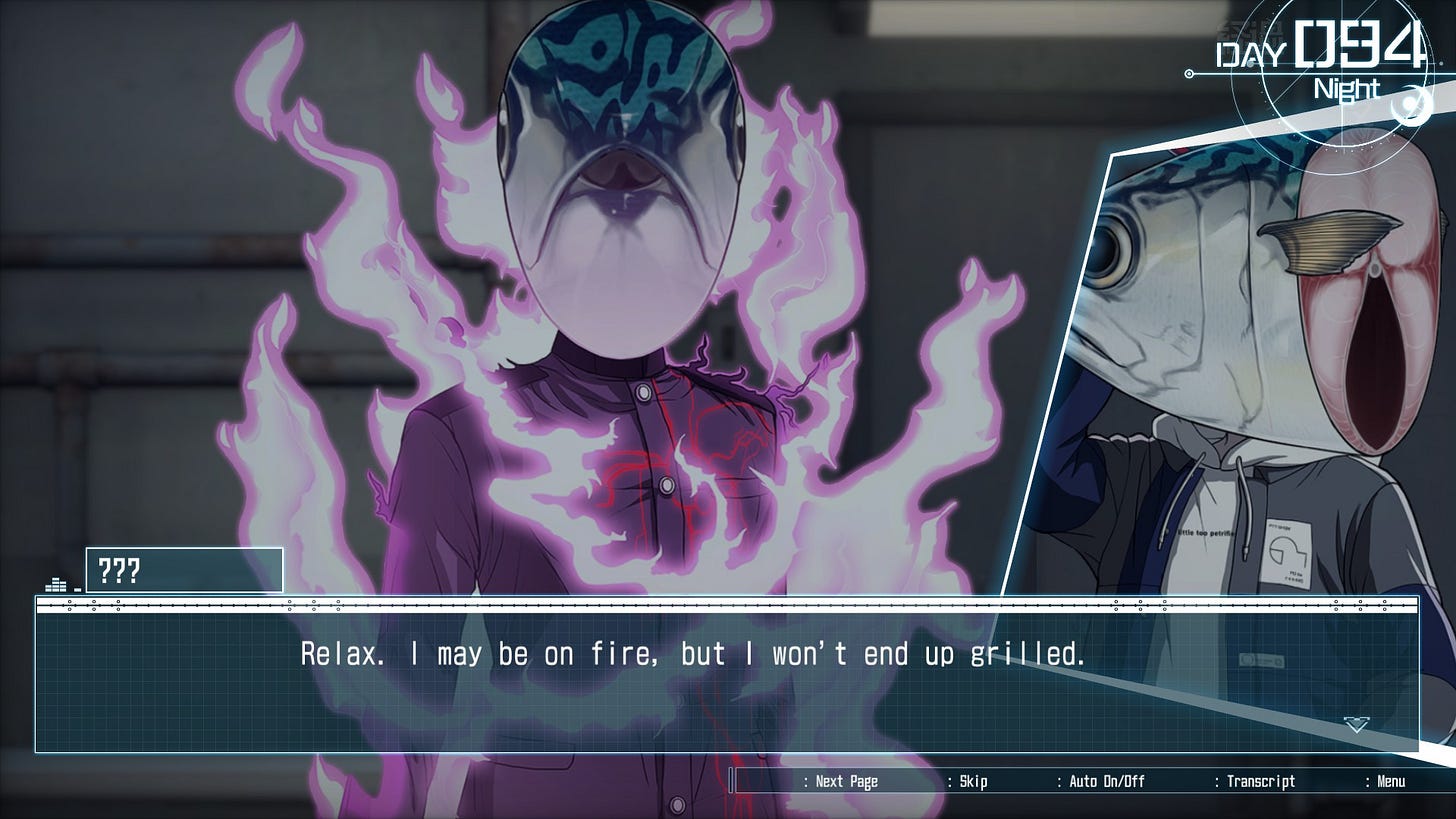







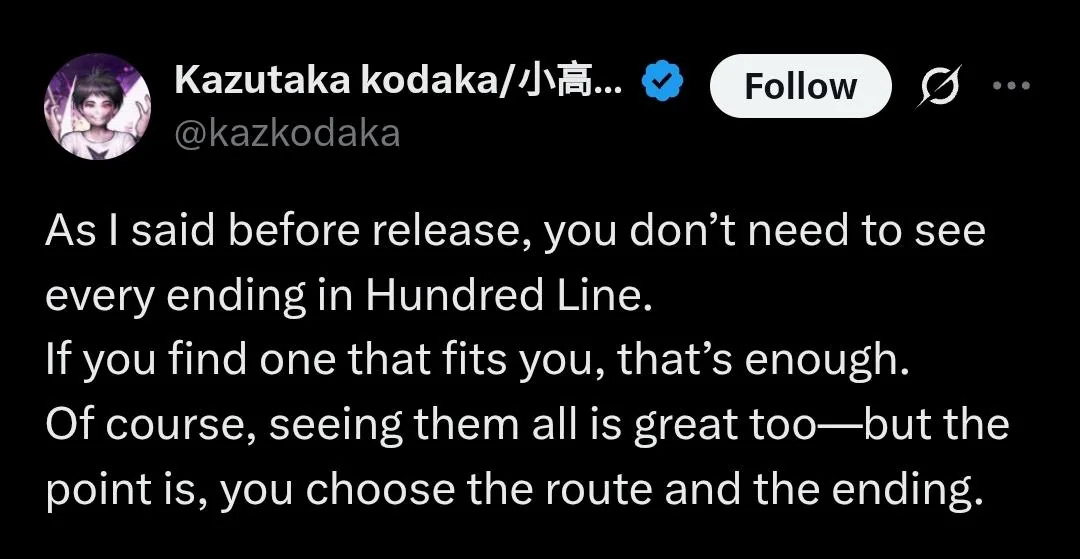
This game bears an uncanny similarity to my dreams. Specifically, the fever dreams I had after sessions of binge-playing Danganronpa long ago. The 100 endings gimmick, the cast of multicolored lab-grown tropehounds, the juxtaposition of weird teddy bear enemies and hell demon commanders. I would wake up in a cold sweat convinced that I'd just dreamed the best game of all time. Why can't someone make something like that in real life?
Well, someone has. And I'm transfixed, I admit it. It's a horrifying monstrosity, but nothing sprawls in quite the same way. If you want to feed your life to a video game and are willing to relax any and all of your standards to do it, this is the game for you.
To be honest, I figured out the "not on earth" and "fighting aliens with aliens" plot twists during the prologue. I did not finish the game, so I did not know about them being clones of the baby. I only made it through 72 hours. I am glad that I stopped. I felt like my brain cells were dying.